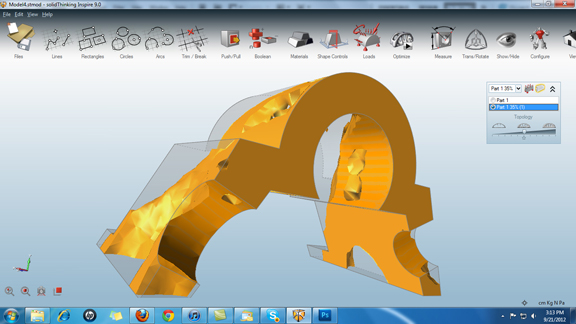Latest News
September 26, 2012
With this punchy title, I may be courting hundreds of unsolicited emails and comments from weight-loss schemes that have nothing to do with the topic of this post, but it seems like an appropriate description. I’ve been subjecting a good number of my 3D designs to a rigorous weight reduction regimen in SolidThinking Inspire 9.0 (now in beta) from Altair Engineering. Their weight loss occurred within a few minutes; the results ranged from 35% to 50% (which is more than what I can say about my own attempt to slim down).
Altair is not in the same business Jenny Craig is. Nevertheless, they both in their own ways are addressing the customers’ issues with excess weight. Altair’s Inspire software is aimed at optimization. In manufacturing, to optimize often means to reduce the mass of the design to the lowest level possible without jeopardizing its performance. If you’re fulfilling an order for half a million units of a particular part, being able to shave off a few centimeters in its depth or height can add up to significant savings in material, production, and shipping costs.
The key is to trim materials where it’s not needed, and reinforce where it makes a difference. The reshaping (it is quite literally reshaping the geometry of your design) is usually driven by simulation and analysis. If you know, for example, the forces on your mounting bracket won’t produce a lot of stress in one corner, that’s the corner you go after for possible trimming. On the other hand, if you know the stress will make its legs buckle, you reinforce them with more mass.That’s why engineers often describe optimization as an iterative process: design, analyze, redesign, analyze again, and so on.
In Inspire, optimization combines analysis and reshaping into a single step. By taking into account the loads, pressures, and torques you’ve specified, the software figures out the stress distribution in your original part, then suggests a possible alternative shape—the optimal shape, as determined by math.
Optimization is by no means a substitute for engineering expertise. In fact, Inspire delivers the optimal shape in mesh clusters, which it not a ready-to-manufacture 3D file. You’ll have to rely on your manufacturing experience and design aesthetics to convert the mesh model into something more sensible and appealing. For better or worse, that’s all on you.
Once, finite element analysis was treated with a mixture of awe and trepidation by average designers, until it became more accessible. Currently, optimization strikes many as a black art, practiced by digital alchemists. Technologies like Altair’s Inspire will go along way to demystify the process and make it more digestible.
A detailed review of SolidThiking Inspire is scheduled to appear in November issue of DE. Inspire is a companion to SolidThinking Evolve, previously reviewed here.
For more, watch the demonstration video below:
Subscribe to our FREE magazine, FREE email newsletters or both!
Latest News
About the Author
Kenneth Wong is Digital Engineering’s resident blogger and senior editor. Email him at [email protected] or share your thoughts on this article at digitaleng.news/facebook.
Follow DERelated Topics








